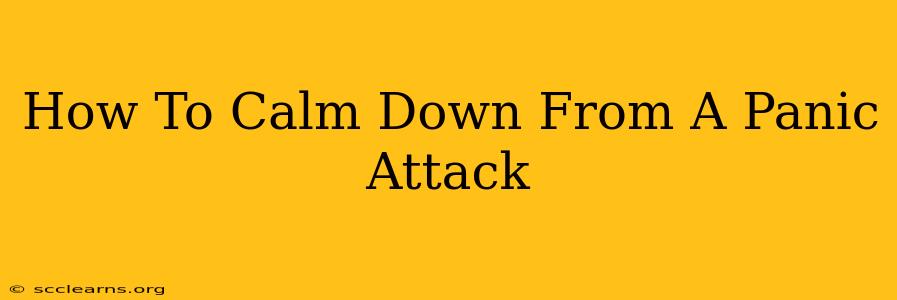Panic attacks can feel terrifying, like a sudden surge of intense fear that overwhelms you. But knowing how to manage them is key to regaining control and reducing their impact on your life. This guide provides practical techniques to help you calm down during a panic attack and learn coping mechanisms for the future.
Understanding Panic Attacks
Before we dive into calming techniques, let's briefly understand what a panic attack entails. A panic attack is a sudden episode of intense fear that may include physical symptoms like a racing heart, shortness of breath, dizziness, trembling, sweating, and chest pain. These symptoms can be incredibly distressing and feel life-threatening, even though they are not.
It's crucial to remember that panic attacks are not a sign of weakness. They are a response to anxiety, and with the right strategies, you can learn to manage them effectively.
Immediate Actions During a Panic Attack
When a panic attack hits, your primary goal is to ground yourself and bring your body back into a state of calm. Here are some effective techniques:
1. The 5-4-3-2-1 Technique
This simple grounding exercise helps shift your focus from the overwhelming sensations to your immediate surroundings:
- 5 things you can see: Name five things you see around you. Be specific – "a blue pen," "a fluffy rug," etc.
- 4 things you can touch: Describe four things you are touching – "the cool surface of my phone," "the fabric of my chair," etc.
- 3 things you can hear: Listen for three sounds – "the hum of the refrigerator," "cars driving by," etc.
- 2 things you can smell: Identify two smells – "the scent of my coffee," "the fresh air coming from the window," etc.
- 1 thing you can taste: Focus on one taste – "the sweetness of my tea," "the slightly salty taste of my lip balm," etc.
This technique redirects your attention from racing thoughts and physical symptoms to the present moment.
2. Deep, Slow Breathing
Diaphragmatic breathing (belly breathing) is a powerful tool for calming your nervous system. Here's how to do it:
- Find a comfortable position.
- Place one hand on your chest and the other on your belly.
- Inhale slowly and deeply through your nose, feeling your belly rise while your chest remains relatively still.
- Exhale slowly through your mouth, feeling your belly fall.
- Continue this for several minutes, focusing on the rhythm of your breath.
Deep breathing helps slow your heart rate and reduce feelings of panic.
3. Progressive Muscle Relaxation
This technique involves systematically tensing and releasing different muscle groups in your body. By releasing the tension, you can reduce overall physical anxiety. Start with your toes, tensing them for a few seconds and then releasing, and gradually work your way up to your head.
4. Physical Activity
If you're able, light physical activity can help burn off some of the excess adrenaline. A short walk, some gentle stretches, or even just marching in place can make a difference.
Long-Term Strategies for Managing Panic Attacks
While these immediate techniques are crucial during an attack, developing long-term strategies is essential for preventing future occurrences and improving your overall well-being. Consider these options:
- Therapy: Cognitive Behavioral Therapy (CBT) and other therapeutic approaches are highly effective in managing anxiety and panic disorders. A therapist can teach you coping mechanisms and help you understand the root causes of your anxiety.
- Lifestyle Changes: Regular exercise, a healthy diet, sufficient sleep, and mindfulness practices can significantly reduce your risk of panic attacks.
- Medication: In some cases, medication may be helpful in managing panic symptoms. Consult with a doctor or psychiatrist to explore this option.
Remember: You are not alone. Panic attacks are a common experience, and there is help available. By learning and practicing these techniques, you can take control of your anxiety and live a more fulfilling life. Don't hesitate to seek professional help if you are struggling.

